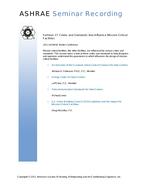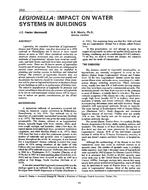Click here to purchase
Environmentally Opportunistic Computing (EOC) is a sustainable computing concept that capitalizes on the physical and temporal mobility of modern computer processes and enables distributed computing hardware to be integrated into a facility “or network of facilities” to optimize the consumption of computational waste heat in the built environment. The first implementation of EOC is the prototype Green Cloud Project at Notre Dame, where waste heat from computing hardware is used to offset the heating demands of the parent facility. EOC performs as a “system-source” thermal system, with the capability to create heat where it is locally required, to utilize energy when and where it is least expensive, and to minimize a building’s overall energy consumption. Instead of expanding active measures (i.e. mechanical systems) to contend with thermal demands, the EOC concept utilizes existing high performance computing and information communications technology coupled with system controls to enable energy hungry, heat producing data systems to become service providers to a building while concurrently utilizing aspects of a building’s HVAC infrastructure to cool the machines; essentially, the building receives ‘free’ heat, and the machines receive ‘free’ cooling. In this work, we present the vision of EOC and the current performance capabilities of the Green Cloud prototype from in situ measurements. Recognizing EOC’s potential to achieve a new paradigm for sustainable building, the research also begins to explore the integration of EOC at the building scale, acknowledging concept-critical collaboration required between architects, computational hardware and software owners, and building systems engineers.
Citation: ASHRAE Conference Papers, Las Vegas, NV
Product Details
- Published:
- 2011
- Number of Pages:
- 8
- File Size:
- 1 file , 500 KB
- Product Code(s):
- D-LV-11-C019


